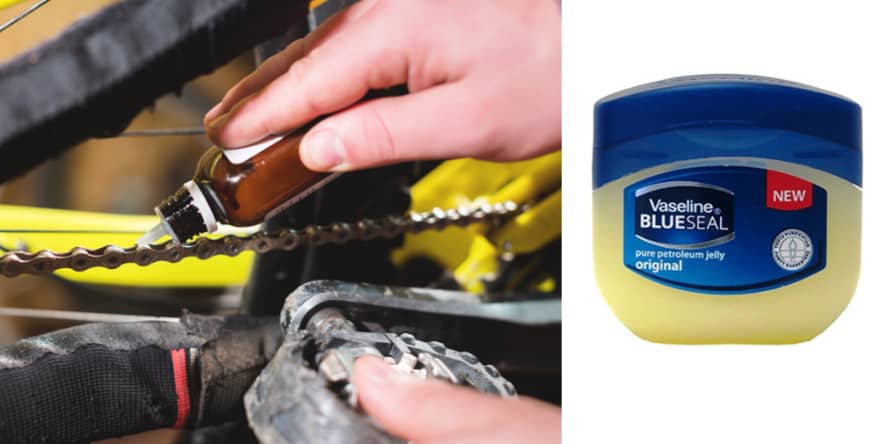
We have all been there, ready to go out for a long ride when you find out that your chain isn’t lubricated properly, but what do you do if you haven’t got any chain lube or bike grease to hand? Well, for many of us it becomes time to fetch the trusty Vaseline as a substitute, however, can you actually use it as bike grease?
Today we will be taking a deeper look into this question by explaining why Vaseline is good to use as grease, the reasons you shouldn’t use it, and whether there are any other alternatives out there. Let’s go.
You can use Vaseline as bike grease as a short-term solution to the problem, but for a more long-term fix, you should always use bike-specific oil or grease as these products have been specially designed for this purpose.
Why Vaseline Is Good To Use
There are a number of good reasons why Vaseline is a good choice when you run out of proper bike grease. Firstly, Vaseline is produced in a similar way to bike grease in the sense that both products have the same base ingredient in them, petroleum jelly.
Petroleum jelly is a common component of grease in general as it has a slippery consistency that allows it to be used on a variety of different surfaces, including bikes.
This makes Vaseline a good option for when you need to replace certain components that will not reach high temperatures at any point (we’ll come back to this later).
Another reason why Vaseline is good is that it is easy to come across in stores and online. When you run out of bike grease and want to go for a ride, it may be a relatively long journey to your local bike store, and this may mean you cannot get there quickly.
Compare this to the wide availability of Vaseline in superstores and local stores alike, it becomes pretty clear why so many people decide to use it instead of traditional lubricants.
Vaseline is also a waterproof product, making it something you can use on a rainy day which for us cyclists is a big plus. Waterproof lubricant won’t wash away when the weather changes or if you through a large puddle or stream on your ride.
The final reason why Vaseline is good to use on bikes is that it is non-corrosive, this means that it will not damage components on your bike by melting or rusting them.
This is of course a major plus point as nobody wants their bike to start melting before their eyes whilst kilometers from home. This being said, Vaseline can cause some damage to plastic components, so just be careful where you apply it.
Reasons Not To Use Vaseline
The major reason why Vaseline shouldn’t be used is that it can melt or ignite. The petroleum jelly that forms the base of the product has a lower boiling point than most jellies with it becoming a liquid at between 40 and 60 degrees Celsius.
Of course, for the most part, it is highly unlikely that you will be riding your bike in these temperatures (or storing them in hot rooms), but for those of you that live in particularly warm parts of the world, it is something to keep in mind.
A second reason why Vaseline can be less helpful than traditional bike grease is that it is far more viscous than many bike-specific greases. This is not a huge issue; however, it can make lubricating the chain of your bike slightly more difficult as you may struggle to reach some of the harder places to lubricate the chain.
Another reason to avoid Vaseline is that it is widely seen as a last resort and ‘quick fix’ solution to any bike-related issue. Whilst the product may not be corrosive to metal, it can cause some minor problems to your chain that are best avoided if you don’t want a much larger job in the near future.
Vaseline will degenerate much faster than bike grease as it is made from petroleum jelly, and this could lead to residue being left on your chain that will need to be cleaned off after your ride to avoid it seizing up.
Are There Any Other Alternatives?

1. Bike Grease
This is what you should buy in the long term, as a product it is designed specifically for use on bikes and contains the right ingredients to keep your bike healthy and greased up.
You can find bike grease at your local bike store and garage (most superstores should stock it too though), as well as online at a variety of websites.
The best bike grease on the market right now is manufactured by a British company called Muc-Off, you can order their ‘Bio Grease’ direct from their website for around $10 per bottle.
2. Cooking Oil
Believe it or not, cooking oils such as olive oil, sunflower oil, and vegetable oils all work pretty well as bike grease alternatives.
The main reason for this is that they have a similar consistency to regular oil that you would use on cars and bikes, whilst they might make your bike smell rather strange on your next ride, they do work as a quick fix.
3. Butter
This may sound like an outlandish suggestion, but I have seen people do it in the past. My advice on this one is that it is not a good idea, butter will degenerate very fast when you step on the pedals.
In theory, it sounds like it could work, but it doesn’t (as a side note, don’t get regular butter confused with chain butter as they are different products. The latter works as a bike-specific kind of butter).
So, Can I Use Vaseline As Bike Grease?
The short answer to the question of this piece is yes, the longer answer is that you should only really use it sparingly if no other better option is present.
You should always endeavor to use products that are made specifically for use on bikes as they have been tried and tested by experts that know how to keep bikes going for longer.
Using Vaseline can cause more harm than good in the long term, so just use it in small doses if you are in desperate need of some grease.
